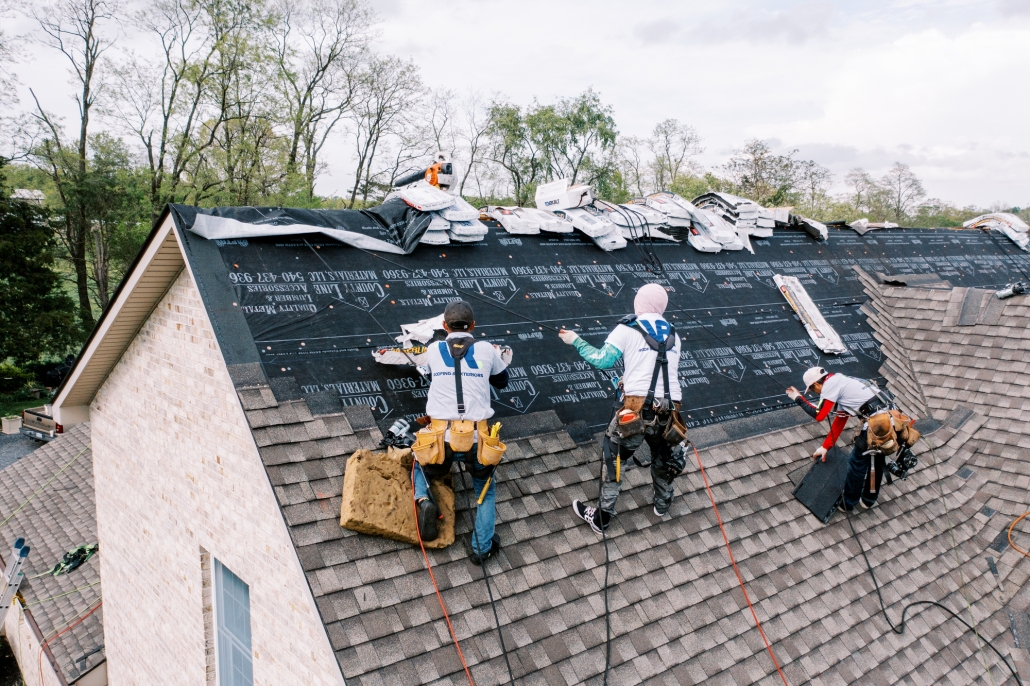Step-by-Step Overview to Discovering the Right Roofing Companies in Gainesville
Step-by-Step Overview to Discovering the Right Roofing Companies in Gainesville
Blog Article
Best Practices for Ensuring Appropriate Roofing Air Flow
A well balanced consumption and exhaust vent proportion, generally 1:300, plays a pivotal function, with intake vents ideally positioned at the reduced side of the roofing system for great air access and exhaust vents at the optimal for cozy air exit. Maintaining insulation away from vents is critical to avoid air movement limitation.
Understand Air Flow Basics
Properly comprehending ventilation basics is necessary for ensuring the longevity and efficiency of roof. Efficient air flow mitigates wetness accumulation and temperature level extremes in the attic, both of which can result in significant structural damage over time. A well-ventilated roof aids in protecting against common issues such as mold and mildew growth, wood rot, and ice dams, which can compromise the honesty of the roof products and the underlying frameworks.
The main goal of ventilation is to help with the movement of air, enabling for a consistent exchange in between the outside and indoor environments. This balance is attained via a combination of intake and exhaust vents that interact to maintain optimum air flow. Intake vents, typically located along the eaves or soffits, allow fresh air to go into the attic area, while exhaust vents, typically located at or near the roof ridge, enable hot, moist air to get away.
Trick aspects influencing the efficiency of roof covering air flow consist of correct placement, ample sizing, and making sure that both consumption and exhaust vents are unobstructed. Normal inspection and upkeep are vital to recognize possible blockages, damage, or ineffectiveness in the ventilation system, thereby securing the roofing system's efficiency and sturdiness.
Kinds Of Roofing Vents
Roof covering vents play an essential role in keeping effective attic ventilation and, by expansion, the total health of the roof system. Numerous kinds of roofing system vents are offered, each with distinct benefits customized to details roof demands.

Soffit vents are installed under the eaves and operate in tandem with roofing vents to ensure a well balanced intake and exhaust system. By allowing cooler air to enter from below, soffit vents assist in the expulsion of warm air with top vents. Gable vents, located on the outside wall surfaces of the attic room, deal another effective remedy, especially in homes with saddleback roofs.
Examine Your Current Air Flow

Following, think about the age and problem of your roof covering materials and ventilation parts. Older systems may not abide by existing building ordinance or might have degraded go to my site in time, minimizing their performance. Conduct a thorough exam to identify any kind of signs of wear and tear, such as corrosion, damage, or spaces that could jeopardize the system's efficiency.
Additionally, determine the attic room temperature and humidity degrees. Heats and moisture can suggest poor air flow - roofing companies gainesville florida. Utilize a hygrometer and thermometer to get exact readings, comparing them Get the facts with outdoor conditions. Persistent discrepancies suggest potential concerns that require addressing.
Setup Best Practices
Efficient setup of roof air flow systems is extremely important for ensuring ideal performance and durability. Proper installation begins with comprehending the specific ventilation requirements of the structure and the roofing system it covers. This entails computing the proper proportion of intake to wear down vents, typically adhering to the 1:300 regulation, which states one square foot of air flow for each 300 square feet of attic flooring area.

The positioning of vents is equally important. Intake vents should be mounted at the roof covering's lower side, typically in the soffits, to enable awesome air to enter. Exhaust vents, on the other hand, need to be installed near or at the roof covering's height to help with the leave of cozy, damp air. This develops a natural airflow that helps preserve temperature level and dampness balance within the attic area.
Seal all vent connections meticulously to stop air leaks and possible water seepage. Use high-quality products and comply with producer guidelines to guarantee sturdiness and efficiency. Furthermore, incorporating ridge vents with baffles can considerably improve airflow efficiency by preventing wind-driven rainfall and snow from getting in the attic room.
Ultimately, accurate setup of roof covering ventilation systems alleviates potential concerns such as mold development, ice dams, and structural damages, guaranteeing the roof's integrity and the building's total wellness.
Routine Maintenance Tips
Consistency in maintenance techniques is fundamental to ensuring the lasting performance of roof covering ventilation systems. Throughout these assessments, ensure that vents are totally free of debris, nests, this content and other obstructions that can hinder airflow.
Cleaning up the vents is one more necessary task. Make use of a soft brush or a vacuum cleaner to remove dust and debris from intake and exhaust vents. Beware not to damage the vent displays or louvers throughout the procedure. Furthermore, inspect the attic space for any kind of indications of water damage, which could endanger the honesty of the roof.
Correct insulation is just as crucial. Make certain that attic room insulation does not obstruct the vents, as this can drastically limit air movement. Rearrange or change it to keep a reliable barrier. if any type of insulation has actually shifted or settled.
Lastly, change any damaged or missing out on parts immediately. Damaged vents, broken tiles, or deteriorated flashing can all add to inadequate air flow and must be addressed right away. Normal maintenance makes certain that the roof ventilation system functions efficiently, consequently extending the life-span of the roof covering itself.
Conclusion
Making certain appropriate roof covering ventilation is paramount for keeping the performance and longevity of a roof. Adherence to the 1:300 intake and exhaust air vent ratio, paired with the tactical placement of vents, is necessary. Normal semiannual examinations, debris cleaning, and making sure insulation does not block air movement are vital practices. Applying these best methods will foster a well-ventilated roof covering system, therefore minimizing prospective concerns associated with moisture build-up and extreme warmth, inevitably prolonging the roof's lifespan.
A well balanced intake and exhaust air vent proportion, generally 1:300, plays a critical function, with consumption vents ideally positioned at the lower edge of the roof covering for great air entry and exhaust vents at the peak for warm air departure. Consumption vents, normally located along the soffits or eaves, permit fresh air to go into the attic room, while exhaust vents, often positioned at or near the roof ridge, allow warm, damp air to leave.
Soffit vents are mounted under the eaves and work in tandem with roofing system vents to make sure a balanced intake and exhaust system. By enabling cooler air to get in from below, soffit vents assist in the expulsion of hot air with upper vents. Adherence to the 1:300 intake and exhaust vent ratio, combined with the critical placement of vents, is vital.
Report this page